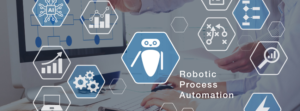By Chief Automation Officer, George K. Mehok
March 8th, 2023
Gartner estimates that more than 56% of organizations have an average of four or more concurrent hyper-automation initiatives underway and leading companies have over ten. The continued growth of hyper-automation initiatives is taking root in organizations that have experienced success with basic task, implementation of enterprise service desk and CRM workflow apps, and legacy system conversation-oriented projects. However, achieving hyper-automation relies on the fusion of an integrated technology architecture and organizational design factors aimed at identifying, prioritizing and managing automation projects.
While over 60% of companies use some form of business process automation and 24% have begun implementing low code process automation tools, leading companies have designed a technology architecture necessary to enable hyper-automation. The question debated by many experts is what technologies are required to achieve transformative results?
This article, the first in the AXI: Hyper-automation series, explores the key technologies that leading companies’ deploy to enable advanced automation capabilities, including:
Process Mapping and Discovery Tools
Event-Driven Integration Platform
Robotic process automation (RPA)
AI / Machine Learning
Data Visualization / BI Framework
Operational Monitoring and Alerting
What is Hyper-automation?
Hyper-automation is a business-driven, disciplined approach that organizations use to rapidly identify, vet, and automate as many business and IT processes as possible. Hyper-automation involves the orchestrated use of multiple technologies, tools or platforms[1].
Hyper-automation is the intersection of business process automation, service-oriented infrastructure and artificial intelligence. The outcome can be transformational, resulting in efficiencies, drive bottom-line financial success, and customer satisfaction that exceeds legacy customer service metrics. Top-line revenue grows as the company’s resources are redeployed to internal innovation energy amplified as a catalyst to new products, services, and in some cases entire new market segments.
From a practical perspective, hyper-automation is analogous to a high-performing sports team composed of a diverse group of elite athletes led by a proven head coach and guided by a dynamic group of front-office executives. The front office collaborates with the head coach to draft the best players possible, and the coach creates an environment where players buy-in to a winning philosophy. They function as an integrated unit by foregoing individual goals for team success. Organizations that succeed with hyper-automation are no different. To achieve transformational benefits management support, collaboration, and teamwork are essential.
Process Discovery Tools
While traditional interview-based process discovery is necessary and vital to capture the as-is state, it is inefficient and time-consuming. Continuous process improvement requires organizations to digitize process DNA utilizing a combination of process mapping software in conjunction with automated task mining tools. Documenting policies, procedures, tasks, and system documentation has been the mainstay of the front-end of process management programs. However, these interview-based activities rely on the knowledge of internal subject matter experts, which contains gaps, biases, and inaccuracies. The next generation of discovery tools includes real-time process information capture to discover, monitor, and validate human and application interactions. These tools capture keystrokes and application event logs as well as apply machine learning techniques to identify the tasks performed in addition to the interoperability of systems.
Learn about Johnson & Johnson’s process discovery best practices.
Event Driven Integration Platform
An event-driven integration platform provides organizations with the integration tools they need to connect their systems, applications, and data across their environment. An integration platform is middleware that enables the development of secure integration flows that connect diverse applications, systems, services, and data stores. In addition, the integration layer provides rapid API creation and lifecycle management to support complex systems integration requirements.
This architecture uses events to trigger and communicate between de-coupled services common in modern applications built with microservices. An event is a state change, or an update, like an item placed in a shopping cart on an e-commerce website. Events can either carry the state (the item purchased, its price, and a delivery address) or events can be identifiers (a notification that an order was shipped).
An event-driven architecture is ideal for enabling advanced process automation due to microservices’ flexible and de-coupled nature. Triggering automation workflows is more efficient than traditional file input-output integrations with RPA tools enabling tight integration at the task level of a business process. Event-driven microservices also enable agility of implementation and change management. Changes can be implemented without complex software changes because the event routing and polling is standardized. Lastly, event-driven integration architectures ensure data is made available to the business and IT sooner, leading to better business insights being uncovered faster.
Learn more about Integration Platform Architecture by IBM
Robotic Process Automation
The use of software robots to perform rule-based, repetitive tasks allow businesses to reallocate resources to support decision-oriented processes. Attended as well as unattended bots integrated and triggered by event-driven APIs are an underlying requirement for a hyper-automation program. However, most automation programs tackle the obvious pain points by building bots to automate manual data entry tasks such as order updates or invoice posting. Nonetheless, hyper-automation RPA techniques build integrated workflows connecting systems, departments, and formerly independent business processes.
Today’s leading RPA tools are designed to easily integrate disparate workflows with a combination of API integrations as well as other automation technologies, including custom artificial intelligence (AI) and machine learning (ML) models, cognitive services such as chatbots and natural language processing (NLP), and document understanding tools.
Learn more about RPA by UIPath
Stay tuned for part two!
[1] https://www.gartner.com/en/information-technology/glossary/hyperautomation




